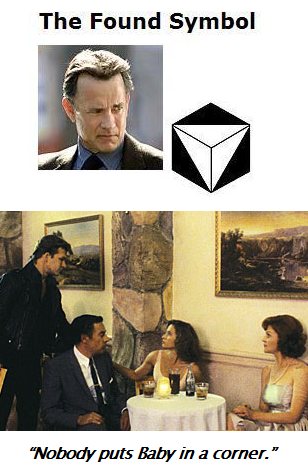|
From The Da Vinci Code,
by Dan Brown
Chapter 56
Sophie stared at Teabing a long moment and then turned to Langdon. “The Holy Grail is a person?”
Langdon nodded. “A woman, in fact.” From the blank look on Sophie’s face, Langdon could tell they had already lost her. He recalled having a similar reaction the first time he heard the statement. It was not until he understood the symbology behind the Grail that the feminine connection became clear.
Teabing apparently had a similar thought. “Robert, perhaps this is the moment for the symbologist to clarify?” He went to a nearby end table, found a piece of paper, and laid it in front of Langdon.
Langdon pulled a pen from his pocket. “Sophie are you familiar with the modern icons for male and female?” He drew the common male symbol ♂ and female symbol ♀.
“Of course,” she said.
“These,” he said quietly, are not the original symbols for male and female. Many people incorrectly assume the male symbol is derived from a shield and spear, while the female represents a mirror reflecting beauty. In fact, the symbols originated as ancient astronomical symbols for the planet-god Mars and the planet-goddess Venus. The original symbols are far simpler.” Langdon drew another icon on the paper.
∧
“This symbol is the original icon for male ,” he told her. “A rudimentary phallus.”
“Quite to the point,” Sophie said.
“As it were,” Teabing added.
Langdon went on. “This icon is formally known as the blade , and it represents aggression and manhood. In fact, this exact phallus symbol is still used today on modern military uniforms to denote rank.”
“Indeed.” Teabing grinned. “The more penises you have, the higher your rank. Boys will be boys.”
Langdon winced. “Moving on, the female symbol, as you might imagine, is the exact opposite.” He drew another symbol on the page. “This is called the chalice .”
∨
Sophie glanced up, looking surprised.
Langdon could see she had made the connection. “The chalice,” he said, “resembles a cup or vessel, and more important, it resembles the shape of a woman’s womb. This symbol communicates femininity, womanhood, and fertility.” Langdon looked directly at her now. “Sophie, legend tells us the Holy Grail is a chalice—a cup. But the Grail’s description as a chalice is actually an allegory to protect the true nature of the Holy Grail. That is to say, the legend uses the chalice as a metaphor for something far more important.”
“A woman,” Sophie said.
“Exactly.” Langdon smiled. “The Grail is literally the ancient symbol for womankind, and the Holy Grail represents the sacred feminine and the goddess, which of course has now been lost, virtually eliminated by the Church. The power of the female and her ability to produce life was once very sacred, but it posed a threat to the rise of the predominantly male Church, and so the sacred feminine was demonized and called unclean. It was man , not God, who created the concept of ‘original sin,’ whereby Eve tasted of the apple and caused the downfall of the human race. Woman, once the sacred giver of life, was now the enemy.”
“I should add,” Teabing chimed, “that this concept of woman as life-bringer was the foundation of ancient religion. Childbirth was mystical and powerful. Sadly, Christian philosophy decided to embezzle the female’s creative power by ignoring biological truth and making man the Creator. Genesis tells us that Eve was created from Adam’s rib. Woman became an offshoot of man. And a sinful one at that. Genesis was the beginning of the end for the goddess.”
“The Grail,” Langdon said, “is symbolic of the lost goddess. When Christianity came along, the old pagan religions did not die easily. Legends of chivalric quests for the lost Grail were in fact stories of forbidden quests to find the lost sacred feminine. Knights who claimed to be “searching for the chalice” were speaking in codes as a way to protect themselves from a Church that had subjugated women, banished the Goddess, burned nonbelievers, and forbidden pagan reverence for the sacred feminine.”
|

























